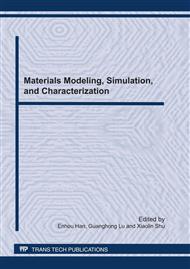p.144
p.149
p.154
p.159
p.168
p.179
p.184
p.190
p.198
Moleculer Dynamics Study of the Thermodynamic Shear Deformation in TiAl/Ti3Al System
Abstract:
TiAl alloys have great potential because of its low density and the outstanding performance at high temperature. However, the brittleness influences its industrialization process. It is known that the macroscopic nature is greatly influenced by its microscopic structure, and the fault development plays a vital role during the material working process. The paper performed the molecular dynamics (MD) study of the thermodynamic shear deformation in TiAl/Ti3Al system to promote the understanding in this aspect. Above all, we adopt a special shear deformation model based on the experimental consideration, and conduct the optimal calculation of the related parameters. Then, a series of thermodynamic deformation simulation were carried out using the previous optimized model. The analysis of the potential variation and the structural snapshots showed that the shear deformation is related with the “stick-slip” behavior. The Ti3Al (TiAl) shows obvious (little) covariant deformation stage before the initiation of the fault transition. For Ti3Al region near the interface, the final structure is the continued FCC stacking. For TiAl, twin and SISF are observed and the block of twin is the main remnant. The atomic diffusion is locally observed in Ti3Al phase. The interface transits the energy and counterpoises the deformation between the hetero-phases.
Info:
Periodical:
Pages:
168-178
Citation:
Online since:
June 2011
Authors:
Keywords:
Price:
Сopyright:
© 2011 Trans Tech Publications Ltd. All Rights Reserved
Share:
Citation:


